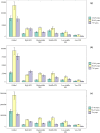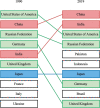The global burden and associated factors of ovarian cancer in 1990-2019: findings from the Global Burden of Disease Study 2019
- PMID: 35907822
- PMCID: PMC9339194
- DOI: 10.1186/s12889-022-13861-y
The global burden and associated factors of ovarian cancer in 1990-2019: findings from the Global Burden of Disease Study 2019
Abstract
Background: Ovarian cancer (OC) is a major cause of cancer-related deaths among women. The aim of this study was to estimate and report data on the current burden of ovarian cancer worldwide over the past 30 years.
Method: Based on the data provided by GBD 2019, we collected and interpreted the disease data of ovarian cancer by incidence, mortality, disability-adjusted life-years (DALYs), and used corresponding age-standardized rates as indicators. Also, we categorized the data by attributed risk factors and captured deaths due to high fasting plasma glucose, occupational exposure to asbestos and high body-mass index, respectively. All outcomes in the study were reported using mean values and corresponding 95% uncertainty intervals (95% UI).
Results: Globally, there were 294422 (260649 to 329727) incident cases in 2019, and the number of deaths and DALYs were 198412 (175357 to 217665) and 5.36 million (4.69 to 5.95). The overall burden was on the rise, with a percentage change of 107.8% (76.1 to 135.7%) for new cases, 103.8% (75.7 to 126.4%) for deaths and 96.1% (65.0 to 120.5%) for DALYs. Whereas the age-standardized rates kept stable during 1990-2019. The burden of ovarian cancer increased with age. and showed a totally different trends among SDI regions. Although high SDI region had the declining rates, the burden of ovarian cancer remained stable in high-middle and low SDI regions, and the middle and low-middle SDI areas showed increasing trends. High fasting plasma glucose was estimated to be the most important attributable risk factor for ovarian cancer deaths globally, with a percentage change of deaths of 7.9% (1.6 to 18.3%), followed by occupational exposure to asbestos and high body mass index.
Conclusions: Although the age-standardized rates of ovarian cancer didn't significantly change at the global level, the burden still increased, especially in areas on the lower end of the SDI range. Also, the disease burden due to different attributable risk factors showed heterogeneous, and it became more severe with age.
Keywords: Global burden of disease study 2019; Ovarian cancer; Risk factors.
© 2022. The Author(s).
Conflict of interest statement
The authors declare no competing interests.
Figures







References
-
- Wild C, Weiderpass E, Stewart B. World cancer report 2020. Lyon: International Agency for Research on Cancer; 2020. pp. 199–512.
Publication types
MeSH terms
Substances
LinkOut - more resources
Full Text Sources
Medical
Miscellaneous

